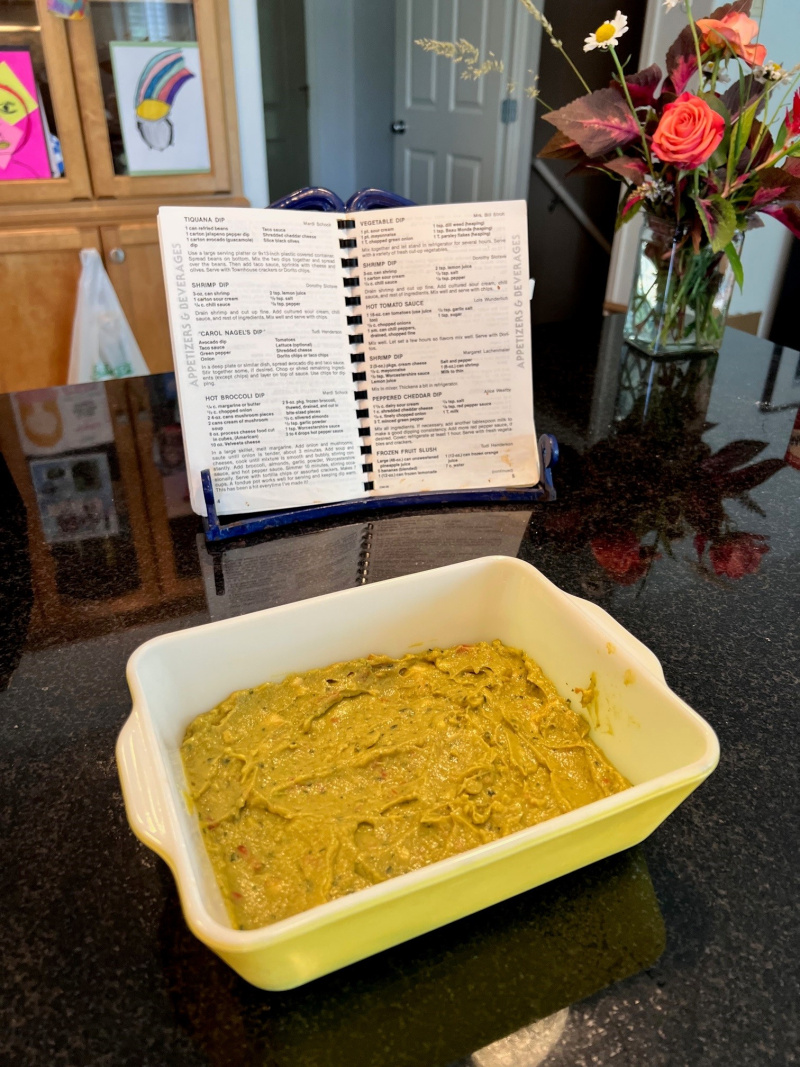The next day of the holiday weekend raised more opportunities for making festive food. We decided to make two more recipes from “Appetizers and Beverages,” both by Tudi Henderson: “Frozen Fruit Slush” and “‘Carol Nagel’s Dip.’”
Frozen Fruit Slush
When they returned from grocery shopping, Luke and the Baby began making the frozen fruit slush to surprise me. Unfortunately for them, but fortunately for me and my research, I arrived home from an errand just as they were beginning.
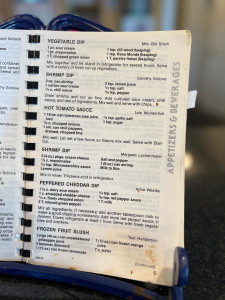
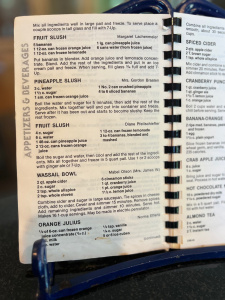
Tudi’s instructions indicate the cook should “mix all ingredients well in large pail and freeze.” Since she leaves the mixing method up to us, we decided to use the blender to ensure a well-mixed fusion of ingredients. First, we filled our blender with the five bananas cut into smaller chunks, then added the frozen lemonade.
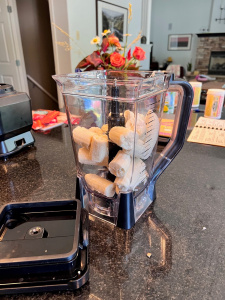
The two shoppers chose pink lemonade for a fun variation. Next came the frozen orange juice, then the large can of pineapple juice, followed by blending until smooth.
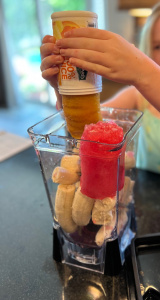
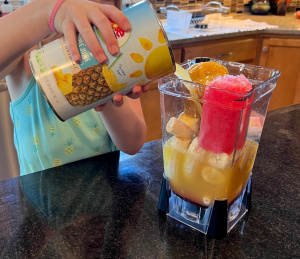
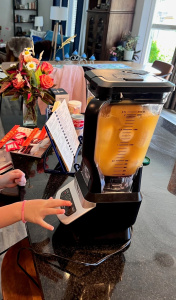
Since the blender wasn’t large enough to add the seven cups of water, we transferred the beautiful orange mixture (no pink visible—shoot!) to our largest Pyrex mixing bowl, as well as to our next largest mixing bowl. Unfortunately, we didn’t have a large enough bucket or container to use for the entire concoction; our giant stainless-steel bowls seemed too shallow for a liquid mixture. Instead, we used a ladle to move the water and blended mixture back and forth across the bowls until they looked identical and until the Baby’s taste-testing pronounced them to taste identical too.
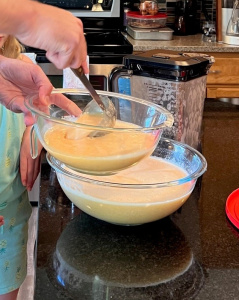
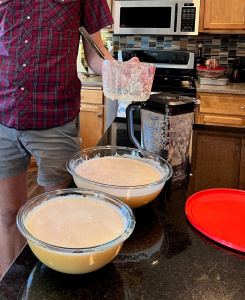
Since the mixture needed to be frozen, I made (a lot of) room in the freezer. And when the Baby was disappointed that we couldn’t have it right away, Luke suggested we put a quart in our amazing ice cream maker, shaped like a ball. It’s able to be used as a ball too—since it needs to be shaken for fifteen minutes, stirred, and shaken again for fifteen minutes, last year we began playing a pool game with it. We toss it to a person, watch them get splashed, and then that person has to pick it up and shake it for a while before splashing the next person. So, obviously, we got in the pool right away to speed up the freezing process (and to have a fun arm workout). Thirty minutes later, we were ready to be refreshed.
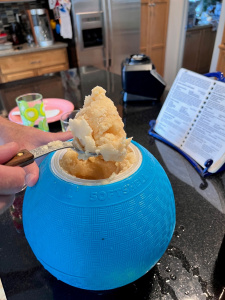
This recipe makes a lot of slush, particularly since Tudi’s serving instructions indicate that the slush mixture is the base for the drink, not the entire drink itself: “To serve place a couple scoops in tall glass and fill with 7-Up.” We didn’t have 7-UP or Sprite, but we had ginger ale and tangerine Izzy drinks, and we tried each variation. This citrus confection was delicious—so refreshing on a hot day! The version with ginger ale was just what I like if I want something not too sweet when it’s hot out. I’m eager to make this again—for kids’ parties, for playdates, for potlucks, and just for hot afternoons.
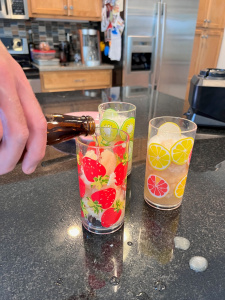
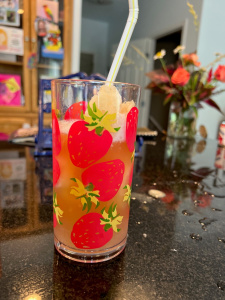
I’m also eager to craft a version for parents, with the addition of rum, vodka, or whiskey. This shouldn’t be difficult because “Frozen Fruit Slush” looks like and tastes like a punch, and there’s certainly a reason that punch has been popular across cultures and centuries. There’s even a book devoted specifically to it, and surprise, surprise, it was written by David Wondrich! Aptly, he called it Punch: The Delights (and Dangers) of the Flowing Bowl (a fantastic title!) and notes that this drink was supremely popular from the late 1600s to the mid-1800s, declaring it “the reigning monarch of the kingdom of mixed drinks” during this period (xiv). In his entry on it in The Oxford Companion to Spirits and Cocktails (for more on this astonishing reference book and its editor-in-chief, see my previous post “Food for Fun in the Sun: Part II”), Wondrich establishes punch’s influence in even more certain terms, calling it “the foundational drink of modern mixology and the first mixed drink based on spirits to gain global popularity. Its descendants—including the Daiquiri, the Cosmopolitan, and the Margarita—remain at the peak of popularity today.”
Wondrich defines punch as “at base a simple combination of distilled spirits, citrus juice, sugar, water and a little spice” (Punch xiv). Hmm…citrus juice, sugar, water, and spice (say, carbonation?)…this seems familiar. And it’s a party drink—Wondrich beautifully describes the feeling evoked by an effervescent gathering serving effervescent refreshments: “most of Punch’s stories are of warm fellowship and conviviality and high-spirited gatherings afloat on oceans of witty talk” (Punch xiv). Sounds like a fantastic party beverage to me (and no surprise here—we have been serving a lot of punches this summer).
And while I wasn’t aware of the popularity of slushes (other than the more famous versions, like Slush Puppies), apparently they are popular in Velva (with the added ingredient of liquor—note that this Lutheran cookbook does not include booze, and while I will ask whether this was intentional or coincidental, it’s not a surprise. It certainly reflects the history of this religion and the influence on American Lutherans of Hans Nielsen Hauge, a layperson who led a pietistic revival in Norway in the early nineteenth century, which produced generations of teetotalers, abstaining from alcohol, dancing, and playing cards—more on Lutherans and alcohol in a future post!). In addition to Tudi’s recipe, The Joy of Sharing includes three other slush recipes, as well as an orange julius, a cranberry punch, and a banana-orange frosty. In the two other Velva community cookbooks I have—the two supervised by Alice Westby and mentioned in Food for Fun in the Sun: Part I—there are a number of slushes, including a delicious rhubarb slush submitted by Rhoda Hagen, my second grade teacher, which I enjoyed when I visited Alice for an interview; Alice likes to use sparkling water as the carbonated liquid. I’ve heard about other compiled cookbooks published by the Velva community too—one by St. Cecilia’s Catholic Church sometime after The Joy of Sharing and another one by the Jayceettes. I will see if I can track down some copies.
Slushes are a revelation! Though I’m seemingly late to the game, I’m a very enthusiastic fan.
“Carol Nagel’s Dip”
To complement our citrusy bubbling beverage and because I love Mexican cuisine, I chose “Carol Nagel’s Dip.” I also like a good mystery (because I like research, of course…). Just like with “Aunt Ellen’s Carrots,” I was dying to know who Carol Nagel was. Luckily, I was scheduled to interview Tudi very soon!
Seeing another use for vintage Pyrex, I pulled out my small, rectangular, yellow dish and spread the guacamole on the bottom, topped with taco sauce. As suggested, I did decide to “stir together some, if desired.”
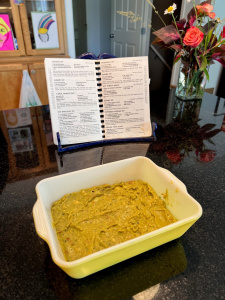
I followed the order of the listed ingredients to create the additional layers—green pepper, onion, tomatoes, and shredded cheese, again from my bag of Mexican blend.
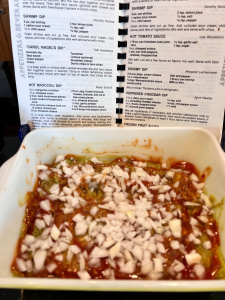
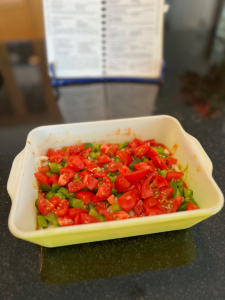
I decided to omit the lettuce, since Tudi lists it as optional, and since I only had arugula, rather than the shredded iceberg I associate with ground beef tacos.
The layers looked beautiful—bright and vibrant, and chopping the ingredients to appropriately the same size made them easy to layer. The recipe didn’t specify letting it sit for flavors to blend, but I did decide to do so since we were also waiting on the frozen slush. The only tricky part of the process was not knowing how much of each ingredient to include, but I decided to let the dish guide the size, adding enough to cover a layer for each element. I like that option!
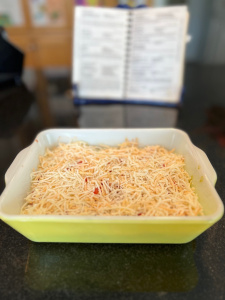
The dip was very good! We ate it with tortilla chips, and the next day again, but as a topping for cheese tostadas. I’m curious about how the flavor might change if eaten with Tudi’s other suggestion—Doritos. I love the creaminess of guacamole, and mixing it with the hot sauce added a nice bit of heat. With the cheese layer on top, it did seem a little dry and difficult to scoop onto a chip; perhaps I used too much shredded cheese. Also, I wonder if an additional layer of a creamy ingredient would act as a binder near the top, like sour cream, salsa, pico de gallo, or refried beans. It might help the chip cut through the layers, as well as connect the veggies and cheese to the bottom layer of avocado-goodness, making a creamy-ingredient “sandwich.” And to add even more flavor and spice, I’d add more traditional guacamole ingredients, like garlic, lime juice, salt, and cilantro. This recipe is flexible, well-suited for adaptation depending on personal taste.
Contributor: Tudi Henderson
Originally from Westhope, ND, a town about sixty miles north of Minot and about seven miles south of the Canadian border, Tudi (Stratton) Henderson is the daughter of Donald and Doris Stratton. After high school in Westhope, Tudi attended NDSU, as did her future husband Ken Henderson. In the 1970s, the couple married and moved to Velva, where Ken taught, coached, directed athletics, and administrated as the high school principal. Tudi’s specialization in early childhood education led to roles as a nanny for many children in Velva. She also was a long-time volunteer at the Souris Valley Care Center in Velva. Tudi and Ken have three sons, Scott, Chris, and Brent, and five grandchildren.
At our recent interview, Tudi shared the origin of her dip recipe. Carol Nagel taught in Velva for two years, from 1977-1979, and since I wasn’t alive yet, that explains why I didn’t recognize her name. Carol was a physical education teacher and the assistant coach for the girls high school basketball team; the head coach was Ken Henderson, Tudi’s husband (non-researched language note—Luke and I both say phy-ed, but our daughter insists that only we say that and that the discipline is called PE or gym. Does anyone else say phy-ed? Or anyone younger than us?). When Carol brought this dip to a party, Tudi asked for the recipe, and clearly enjoyed it enough to contribute it to The Joy of Sharing. In fact, when I went looking through the Velva School and Community Cookbook to find the rhubarb slush recipe Alice served, I found these two recipes, again in the “Appetizers & Beverages” section, both contributed by Chris Henderson, Tudi’s son. They must be family favorites!
Tudi is my mother’s friend and has the most sparkling personality. She is a great conversationalist—curious, engaging, and kind—really, effervescent is a suitable adjective, much like her slush recipe. She mentioned that she hasn’t made this slush recently, but that she does still make slushes often, as well as egg bakes, including the one she contributed to the cookbook, “Breakfast Buffet Brunch.” When we met, we had a great conversation about the ways in which Tudi has seen cooking responsibilities shift throughout seasons of life and cultural changes; when her children were living at home, she noted that she had to cook, particularly because of living in a small town with few options at the end of the day. Tudi also shared that what she cooked was affected by the nature of a busy family life—they had to run to sports and other activities and so food had to be adapted to their schedules; consequently, they had a lot of hotdish. Like many people, Tudi says she doesn’t mind cooking but that she “dreads and despises cleaning up,” which does affect how often she wants to cook now. Her other contributions to The Joy of Sharing are “Garlic Bubble Loaf,” “Pizza Noodle Bake,” “Frontier Salad,” and “Natural Fruit Popsicles.”
This post is part of an ongoing series in which I make and reflect on recipes and the people who contributed them to the 1985 Oak Valley Lutheran Church compiled cookbook, The Joy of Sharing.

